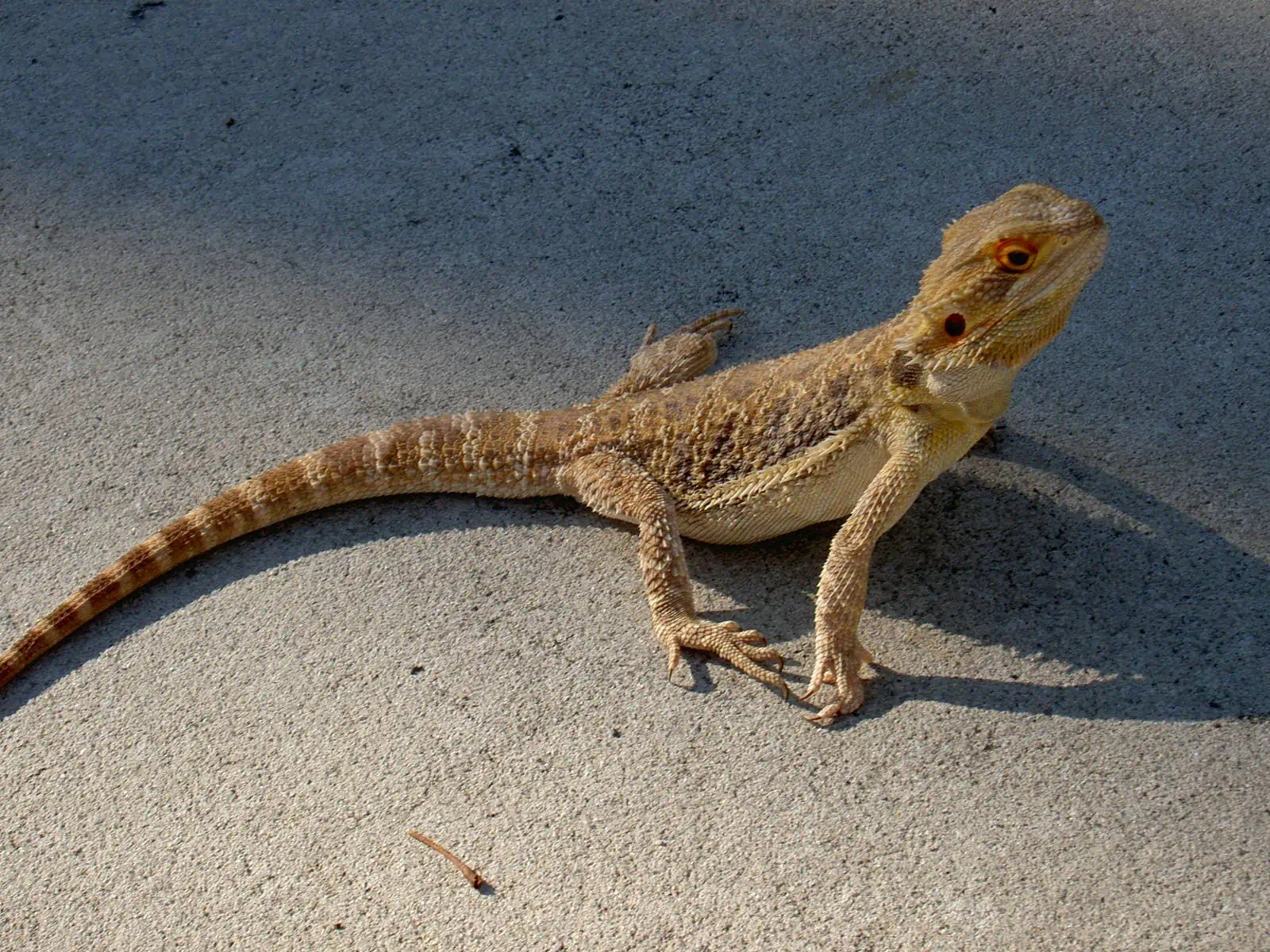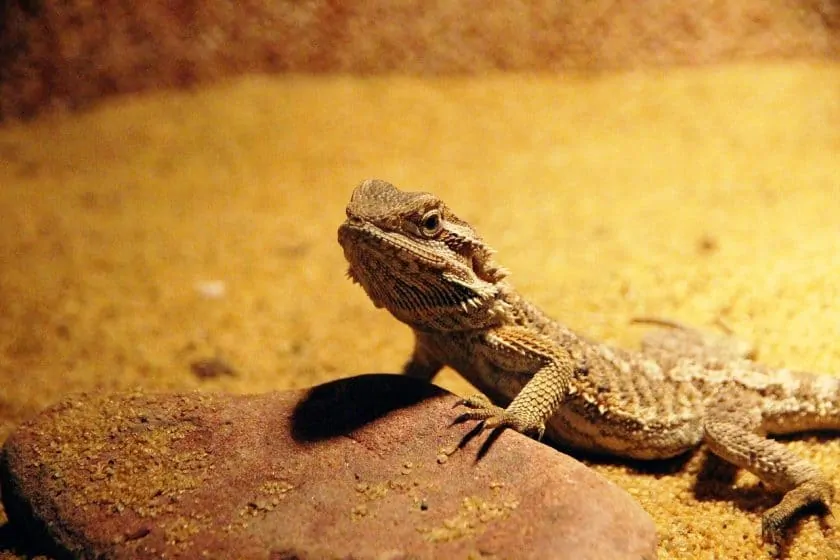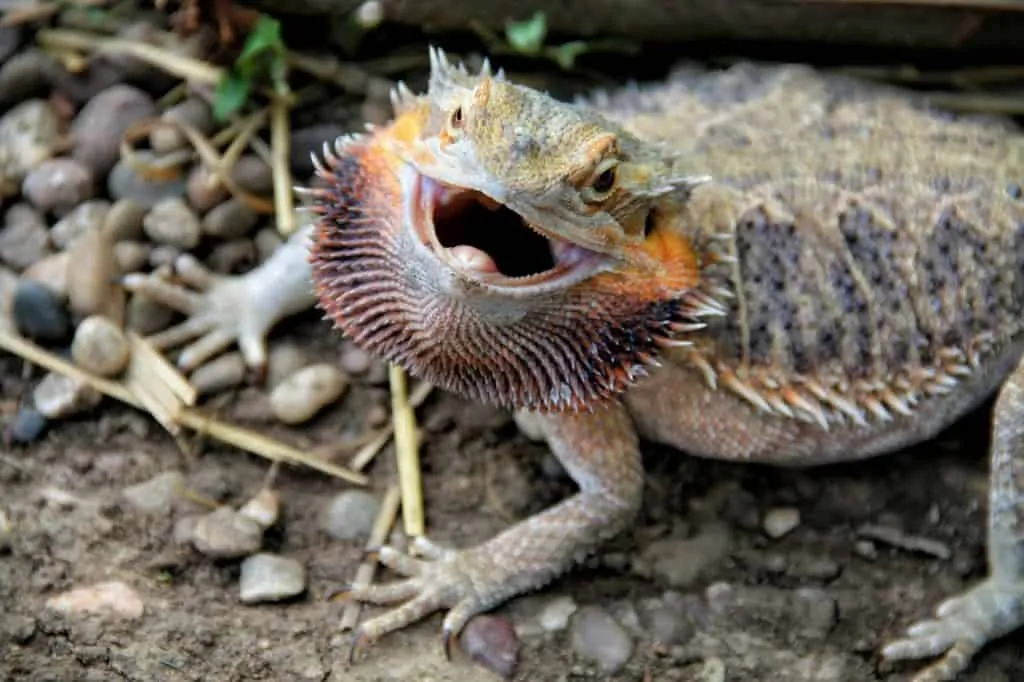In the world of bearded dragons, MBD is not a rarity but a widespread reality. Many of these charismatic reptiles get this every year – which is worrying. MBD is not just a health issue; it’s a reflection of the care and environment we provide for these fascinating creatures. Because of not getting the right nutrients, they can have big problems with their bones and muscles, making them lose their lively spirit.
Knowing about MBD is important for reptile owners as it helps prevent and manage this disease effectively.
The main things that cause MBD in bearded dragons are:
- Not enough Calcium: They need this for strong bones and muscles.
- Not enough UVB light: This is very important for making Vitamin D3, which helps them use the calcium they eat.
- Dietary Imbalances: They need the right amounts of calcium, phosphorus, and oxalates in their diet.
- The wrong temperature: This can mess up how they digest food and absorb nutrients.
- Other things, too: Like their genes and stressful living conditions.
In this article, we’re going to really dig into MBD:
- Looking at symptoms
- How to treat it
- And tips to keep your scaly friend healthy.
Understanding Metabolic Bone Disease
Metabolic Bone Disease (MBD), also known as nutritional secondary hyperparathyroidism or fibrous osteodystrophy, is prevalent in domesticated bearded dragons, particularly in juveniles. It’s caused by insufficient certain nutrients, mainly calcium and Vitamin D3. Too much phosphorus in their diet can also lead to this disease.
MBD is bad for bearded dragons and can hurt them in many ways. Let’s look at how MBD gets worse over time and what it does to them:
- Initial Stage: At first, the dragon’s body begins taking calcium from its bones because it’s not getting enough from food and UVB light, making the bones weak and easy to break. The bearded dragon may feel pain and find it hard to move around.
- Progression: As the disease advances, the bones become extremely soft and fragile, which can lead to deformities such as bent or dragging limbs and green-stick fractures (where bones bend rather than break). Muscle twitching and spasms may occur, giving the appearance of constant trembling.
- Advanced Stage: In severe cases, the dragon might have seizures often, lose its appetite to the point where it needs to be fed with a syringe, and be very weak. Physical deformities become more pronounced, and the dragon might appear frail, with limp limbs unable to support its weight.
- Terminal Stage: If MBD isn’t treated, the lack of calcium will really hurt the dragon’s muscles, and the muscles get weaker and can’t work right, leading to paralysis of the limbs, lots of pain, and, in the end, death.
Symptoms of MBD
Metabolic Bone Disease (MBD) in bearded dragons is a concerning yet preventable condition. It manifests through various symptoms that evolve as the disease progresses. Below, I’ve provided the most noticeable symptoms to help you better understand the disease.
Early Signs and Symptoms
In the initial stages – MBD symptoms in bearded dragons can be subtle yet indicative of underlying issues. Keep an eye out for these signs:
Physical Symptoms:
- Loss of Appetite
- Constipation
- General Weakness
- StressLethargy
Behavioral Indicators:
- Decreased activity and movement
- Difficulty in lifting the body off the ground
- Showing signs of discomfort or pain
- Reduced interaction or response to stimuli
While the physical symptoms indicate potential health issues, it’s important to recognize that these signs are not exclusive to Metabolic Bone Disease (MBD) because conditions like gut impaction can also present with similar symptoms.
Therefore, if your bearded dragon exhibits these symptoms, I recommend you consider consulting a veterinarian for an accurate diagnosis, as the observed symptoms might not necessarily point to MBD alone.
Moderate to Advanced Symptoms
As MBD advances, symptoms become more pronounced and concerning, indicating your pet is dying slowly:
- Spinal Deviation: Noticeable changes in the spine’s alignment.
- Stunted Growth: Hindered physical development.
- Drooping Lips and Soft Facial Bones: Visible changes in facial structure.
- Muscle Twitching and Swollen Limbs: Signs of severe calcium deficiency affecting muscles and bones.
- Receded Lower Jaw and Greenstick Fractures: Indicative of weakened bone structure.
- Paralysis, Seizures & Tremors: Indicating effect on the muscular system of the dragon.
- Swollen Jaw and Bone Fractures: A common symptom due to brittle bones.
Causes of MBD in Bearded Dragons
Metabolic Bone Disease (MBD) in bearded dragons usually stems from improper care, though there isn’t a single definitive cause. Below I have discussed the primary factors contributing to MBD:
1. Insufficient Calcium Intake
Calcium plays a vital role in maintaining a bearded dragon’s health, particularly in bone development and muscle function. And if they don’t get enough calcium from their food, they can get MBD. So, it’s key to feed them foods that are rich in calcium.
2. Inadequate UVB Exposure
UVB light helps bearded dragons make Vitamin D3, which they need to use the calcium they eat, and if they don’t get enough UVB light – they won’t be able to absorb calcium properly, and that can cause MBD.
3. Dietary Imbalances
Another big reason for MBD is their diet isn’t balanced, especially with calcium, phosphorus, and oxalates. When the diet is high in phosphorus or oxalates, these substances can inhibit calcium absorption. Phosphorus and oxalates bind with calcium, making it unavailable for the dragon’s body, leading to calcium deficiency.
Therefore, it’s crucial to maintain a diet with a balanced calcium-to-phosphorus ratio, ideally 2:1, and to help prevent an imbalance, limiting foods high in oxalates and phosphorus is essential, such as:
- Bananas
- Spinach
- Broccoli
- And beans
4. Improper Temperature Conditions
Bearded dragons are cold-blooded. They need the right temperature to digest vitamins, minerals & calcium; without the right heat, they can’t process these nutrients well, leading to MBD.
5. Other Contributing Factors
Other factors can make bearded dragons get MBD:
- Genetic Predispositions: Some bearded dragons may have genetic tendencies that make them more susceptible to MBD, regardless of their care and environment.
- Environmental Stressors: Stressful conditions, such as improper habitat setup, overcrowding, or inadequate temperature and humidity levels, can negatively impact a bearded dragon’s overall health, potentially exacerbating the risk of MBD.
- Age & Growth Phase: Younger bearded dragons, especially those still in their growth phase, are more prone to developing MBD due to their higher nutritional needs.
Diagnosing and Treating MBD
Now that we know a bit about MBD in bearded dragons, let’s look at how vets figure out if a dragon has it and how they treat it.
Veterinary Diagnosis
Professional diagnosis is vital to accurately identify MBD in bearded dragons, as many of its symptoms can be similar to other conditions. Here’s what the vet usually does:
- Diet and Husbandry Review: First, the vet will ask about what the dragon eats and its living conditions. This helps figure out why it might have MBD.
- Physical Exam: The vet will give the dragon a complete check-up to look for signs of MBD.
- X-ray Exam: The dragon is put to sleep for a bit to get a clear picture. Then, X-rays of its long bones, spine, and head are taken to look for breaks or odd shapes.
- Blood Tests: These tests check for things causing MBD. And they measure the calcium, phosphorus, and vitamin D levels in the dragon’s blood. They also check how the kidneys are doing because problems there can lead to MBD.
Treatment Options
How we treat MBD depends on how bad it is. For mild cases, adding more calcium-rich foods might be enough, but with worse MBD, the vet might suggest changing the diet and other medical treatments.
1. Medical Interventions
- Vitamin D3 Injections: These are important to help the dragon use calcium properly, and they’re especially needed if the dragon isn’t getting enough natural UVB light.
- Calcitonin Injections: This medicine raises calcium levels in the body, and it’s used for more serious MBD cases.
- Other Medications: The vet might also give medicines for pain or infections.
- Splints or Casts for Broken Bones: If MBD has caused broken bones, the dragon might need splints or casts to help the bones heal.
2. Dietary Adjustments and Supplements
- Oral Calcium Supplementation: Usually, the vet will suggest giving calcium as a powder or liquid. You can mix this with your dragon’s food. This step is really important because most insects that dragons eat have more phosphorus than calcium. Adding calcium supplements to their food helps fix this imbalance.
- Proper Diet and Nutrition: The vet can also help you determine the best diet for your dragon. It should have lots of calcium and not much oxalates and phosphorus. These can stop calcium from being used properly by your dragon’s body. Here are some great foods that are high in calcium for your dragon:
- Chicory and dandelion leaves
- Cactus leaves and prickly pear
- Figs
- Endive and escarole
- Mustard greens
- Turnip greens and collard greens
- Papaya and squash
- Kale
- Arugula
Soft-shelled insects like Phoenix worms, Hornworms, and silkworms also make good calcium sources.
Important Note: Calcium supplements should be given carefully, as bearded dragons may not absorb all types of supplements effectively. I recommend pet parents Calcium gluconate as it’s easily absorbed after ingestion.
Recovery and Management
After delving into the treatment, it’s time to focus on recovery and management strategies. Along with a treatment plan, your vet will also ask you to provide dedicated home care – so you can greatly improve your pet’s health.
- Maintain Optimal Habitat Conditions: Creating the right living space is key for your dragon’s recovery. And this means having the right temperature and light, especially UVB light, which is very important. Your dragon needs a warm spot in its tank, around 95-110 degrees Fahrenheit, and a cooler area, too. At night, keep the temperature between 70-75 degrees Fahrenheit. Beardies need about 8 to 12 hours of UVB light each day. Make sure you have a good UVB bulb and put it in the right spot in the tank for the best effect.
- Keep Your Dragon Hydrated: Proper hydration aids in the absorption of calcium, Vitamin D3, other nutrients, and joint lubrication. Talk to your vet about how much water your dragon needs. And be sure the water bowl isn’t too deep. This is to stop your dragon from possibly drowning.
- Handle With Care: Bearded dragons with MBD should be handled when necessary and with great care due to their fragile state.
- Rearrange the Terrarium: Remove potential hazards from the terrarium that could cause injury or hinder movement, such as sticks or rocks. And ensure ease of access to areas like the basking rock.
- Long-Term Health Management: After recovery, ongoing care is vital. Besides maintaining a suitable environment and diet, it also includes regular vet check-ups, which are essential to monitor the progress and tweaking the treatment plan as needed.
How Long Does It Take to Heal MBD?
Healing Metabolic Bone Disease (MBD) in bearded dragons is influenced by several factors, leading to variable recovery times. Severe cases can take months to heal, sometimes up to six months for normal movement. Mild cases, however, often show significant improvement within weeks. Key factors affecting healing include:
- The disease’s severity
- Quality of care
- Diet
- Calcium and vitamin D supplementation
- UV light exposure
It’s possible to completely cure mild MBD, but severe MBD might leave lasting effects, even with treatment. The dragon could stay a bit deformed. That’s why keeping up with the right diet and living conditions is important to prevent MBD from returning.
Responsibility Is Owed
Understanding Metabolic Bone Disease in bearded dragons is crucial for every reptile enthusiast. It is a reversible condition that significantly impacts the quality of life of these beloved reptiles, and your role as a caretaker is key to stopping this tough condition. Fighting MBD means ensuring your dragon’s diet has lots of calcium, they get enough UVB light & their home has the right temperature. Being aware and acting early can stop this disease.
Are you ensuring the right diet? Are you making sure they get enough UVB light? What could you change to make your dragon’s life better? Share your thoughts with us…





